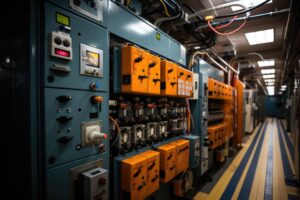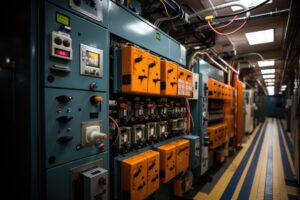Can You Connect a Generator to Your House Without a Transfer Switch?
Key Takeaways
- Connecting a generator to your house without a transfer switch can provide temporary power during power outages or emergencies.
- Connecting a generator without a transfer switch is the least expensive option compared to installing a transfer switch.
- With the right knowledge and understanding of electrical systems, it is possible to safely connect a generator to your house without a transfer switch.
Many homeowners may wonder if it is possible to connect a generator to their house without a transfer switch. While it is technically possible to do so, there are several important factors to consider before attempting this method. In this article, we will explore the pros and cons of connecting a generator to your house without a transfer switch, as well as alternative methods that can be used. It is important to note that safety should always be the top priority when dealing with electrical systems, and any modifications should be done with proper knowledge and understanding.
Pros of Connecting a Generator Without a Transfer Switch
There are a few advantages to connecting a generator to your house without a transfer switch:
- Temporary power in emergency situations: Connecting a generator without a transfer switch can provide temporary power to your home during power outages or emergencies.
- Least expensive option: Compared to installing a transfer switch, connecting a generator without one is the least expensive option.
- Can be done with proper knowledge and understanding: With the right knowledge and understanding of electrical systems, it is possible to safely connect a generator to your house without a transfer switch.
Cons of Connecting a Generator Without a Transfer Switch
However, there are significant drawbacks and risks associated with connecting a generator to your house without a transfer switch:
- Major safety risk: If grid power and generator power become connected at the same time, it can pose a major safety risk, potentially causing damage to electronics, appliances, and the electrical system.
- Potential damage to electronics and appliances: Sudden changes in power can lead to damage to electronics and appliances, as well as compromised electrical systems.
- Risk of hazardous voltage feedback: Without a transfer switch, there is a risk of hazardous voltage feedback from the grid into the generator, which can cause harm to both the electrical system and individuals.
- Increased risk of electrical fire and carbon monoxide poisoning: Improperly vented exhaust fumes from the generator can lead to an increased risk of electrical fires and carbon monoxide poisoning.
- Overloaded circuit: Mismatched amperage between the generator and house circuits can result in an overloaded circuit, potentially causing damage to the electrical system.
- Requires manual switching of appliances: Connecting a generator without a transfer switch requires manually switching appliances from grid power to generator power, which can be inconvenient and time-consuming.
- Potential safety hazards: Running an extension cord through an open window or door, which is often necessary when connecting a generator without a transfer switch, poses potential safety hazards.
Alternative Methods
While connecting a generator without a transfer switch may be possible, it is generally not recommended due to the safety risks involved. However, there are alternative methods that can be used:
- Using extension cords: One alternative is to directly power appliances from the generator using extension cords. This method allows for more flexibility in powering specific appliances, but it requires careful management of power distribution and can still pose safety risks.
- Installing a dedicated outlet box: Another alternative is to install a dedicated outlet box connected to a specific circuit in the main electrical panel. This allows for a more permanent solution and reduces the need for running extension cords, but it still requires manual switching of appliances.
- Using an interlock kit: An interlock kit is a device that allows the generator and main utility power to work together without backfeeding. This method provides a safer and more convenient way to connect a generator to your house, but it may require professional installation.
It is important to note that these alternative methods should be approached with caution and should only be implemented if you have a clear understanding of electrical systems or with the assistance of a qualified electrician.
Safety Risks and Legal Implications
Connecting a generator to your house without a transfer switch poses significant safety risks, including the potential for damage to electronics and appliances, compromised electrical systems, hazardous voltage feedback, overloaded circuits, electrical fires, and carbon monoxide poisoning from improperly vented exhaust fumes.
Furthermore, not using a transfer switch is against the National Electric Code and can result in legal complications and invalidated insurance claims. It is crucial to comply with regulations and codes to ensure the safety of both individuals and utility workers.
Related Websites:
FAQs:
Q: What is a generator transfer switch?
A generator transfer switch is a device that allows you to safely and seamlessly switch the power supply between your generator and the utility grid. It is an essential component of a generator setup, ensuring proper operation and preventing any backfeeding of electricity.
Q: How does a generator transfer switch work?
A generator transfer switch controls the flow of electricity between your generator and the utility grid. It works by automatically or manually diverting the power supply to the desired source. Automatic transfer switches detect power loss and initiate the switch, while manual transfer switches require you to manually activate the switch.
Q: Is it possible to connect a generator to a house without a transfer switch?
While it is technically possible to manually connect a generator to a house without a transfer switch, it is not recommended. Doing so can pose serious safety risks and may damage your appliances, equipment, or the generator itself. It is best to use a transfer switch to ensure safe and proper operation.
Q: What are the risks and drawbacks of connecting a generator without a transfer switch?
Connecting a generator to a house without a transfer switch can lead to safety hazards such as electrical shock or fire. It can also damage sensitive appliances and equipment due to inconsistencies in power supply. Additionally, improper connections can cause harm to the generator, potentially voiding warranties or causing malfunctions.
Q: Are there alternatives to a transfer switch for connecting a generator?
Yes, there are alternative methods for connecting a generator without a transfer switch, such as interlock devices or breaker interlocks. These devices prevent backfeeding and allow selective power distribution, but they have limitations in terms of capacity and may not be as reliable as a transfer switch. Consulting a professional is recommended to determine the best alternative for your specific setup.






